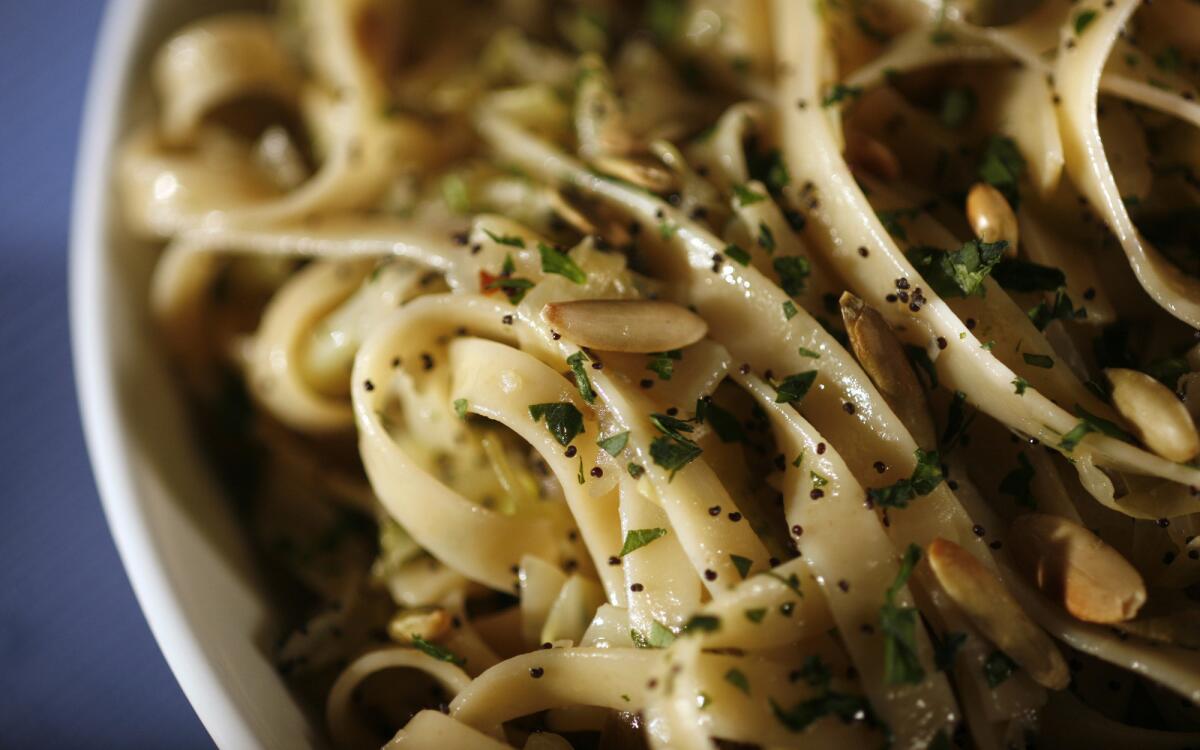Noodles with cabbage, poppy seeds and pepitas

You may know that Queen Esther is the heroine of the joyful holiday of Purim, which begins Wednesday evening. She was the beautiful Jewish woman selected by the King of Persia to be his wife. After she became queen, she begged the king to save her people from Haman’s wicked plan to destroy them. He did, and thus the Jews were saved.
But did you know that Esther might have been a vegan?
When the rabbi at Hebrew school taught our class that Queen Esther was said to have lived on seeds and nuts because she could not get kosher food at the king’s palace, I couldn’t imagine anyone eating like that. In our home, seeds appeared as the poppy seeds on challah and the caraway seeds in rye bread, and the most familiar nuts were the bits of walnuts that my mother sometimes added to brownies.
Yet seeds and nuts have countless uses beyond their most familiar roles as snacks and garnishes. They are made into a variety of sauces and dips, like Middle Eastern tahini, or sesame sauce, the Persian walnut pomegranate sauce called fesenjan and Mexican pipian sauce made from pumpkin seeds.
Some say Queen Esther’s diet also included legumes, the “seeds” of bean pods. Today we would call Queen Esther a vegan, the term for vegetarians who avoid all animal products, including dairy foods and eggs.
As a tribute to Queen Esther’s diet, many cooks make a point of including seeds and nuts in their meals for the holiday. For a memorable Purim celebration, why not prepare a wholly vegan menu?
You might start with noodles with poppy seeds, Purim’s signature ingredient. In some families of Ashkenazi origin, the seeds are popular as a topping for buttered noodles. On a vegan menu, poppy seeds, paired with roasted pepitas, provide a bit of crunch and a subtle nutty flavor to noodles dressed with slightly sweet caramelized onions and cabbage.
Some say Queen Esther’s diet also included legumes, the “seeds” of bean pods, and adding garbanzo beans to the Purim meal is another way that Esther’s diet is honored in many Jewish households. The freshly cooked beans, served hot with a drizzle of olive oil and a sprinkling of salt and pepper, make a tasty appetizer.
For a vegan Purim menu, serve garbanzo beans as part of a vegetable and sesame feast. Modeled on a Provencal specialty called le grand aioli, composed of fish and cooked vegetables served with garlic mayonnaise, our Middle Eastern twist has garbanzo beans to stand in for the fish and pale green herb-and-garlic-flavored tahini sauce instead of the egg-yolk-based aioli.
A colorful assortment of cooked vegetables, including carrots, broccoli and Korean radishes, served alongside roasted eggplant and shiitake mushrooms, rounds out the tempting platter; you can add baby potatoes, cauliflower, green beans or whatever is freshest at your market. Toasted sesame seeds sprinkled over the vegetables are a tasty reminder of Queen Esther’s seed-based diet.
In addition to hamantaschen -- the ear-shaped cookies -- which are of Ashkenazi origin, some like to serve Sephardi nut and filo pastries such as Haman’s fingers. Unlike many filo dessert pastries, these simple sweets need no syrup. Although they don’t have much sugar and are brushed only lightly with oil, their cinnamon-scented filling of walnuts, almonds and pine nuts makes them absolutely delicious.
Levy is the author of “1,000 Jewish Recipes,” “Feast From the Mideast” and “Healthy Cooking for the Jewish Home.”
Quarter the cabbage lengthwise. Put each quarter on its side and shred with a heavy knife by cutting the cabbage in thin slices, first crosswise, then around the core; remove the core and any thick ribs. You should have 11 to 11 1/2 cups shredded cabbage.
Heat 3 tablespoons of oil in a wide, heavy stew pan. Add the onions and cook over medium heat, stirring occasionally, until they begin to turn golden, about 18 minutes. Add the cabbage, and season with a pinch each of salt and pepper. Cook uncovered over medium heat (the cabbage will seem like a very large amount at first, but it will cook down), stirring often, until the vegetables are very tender, about 20 minutes. While the cabbage is cooking, bring a large pot of salted water to a boil.
Sprinkle the mixture with sugar and cook over medium-high heat, stirring often, until the vegetables are lightly browned, about 7 minutes.
Meanwhile, cook the noodles uncovered in the boiling water until al dente according to the instructions on the pasta packaging (check the pasta 1 to 2 minutes before the time indicated to make sure it isn’t already done). Drain, reserving one-half cup of the pasta cooking liquid.
Add the noodles to the pan of cabbage. Toss over medium-low heat for 1 minute. Add about 3 tablespoons of the reserved noodle cooking liquid, or enough to moisten the mixture lightly, and cook until the noodles are well coated with the cabbage mixture, 1 to 2 minutes. Stir in the poppy seeds. Off heat, add the remaining tablespoon of olive oil.
Stir most of the pepitas and parsley with the pasta and cabbage, leaving about one-fourth of each to sprinkle over as garnish. Taste, and adjust the seasoning as desired. Serve hot, sprinkled with the reserved pepitas and parsley.
Get our Cooking newsletter.
Your roundup of inspiring recipes and kitchen tricks.
You may occasionally receive promotional content from the Los Angeles Times.















